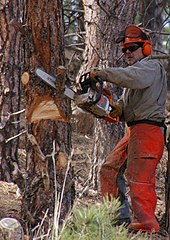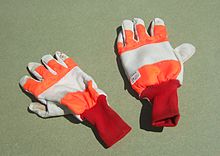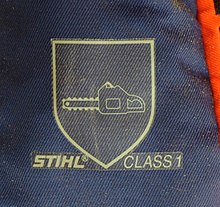Chainsaw safety clothing
[1][2] There is general agreement worldwide on what clothing is suitable, but local jurisdictions have specific rules and recommendations.
The helmet offers some protection for the user's head against impact by the cutter bar of the chainsaw, should a 'kickback' occur.
The relatively flimsy mesh visor, with imperfect coverage of the face, is considered acceptable, because the chips produced by well-maintained chainsaws are of relatively uniform size and speed.
Unlike other woodworking tools, a chainsaw with a sharp chain produces little or no sawdust, only chips (which are too large to fit through the visor's mesh).
The visor provides ventilation for hard work in hot weather, but safety goggles can prevent smaller pieces of debris from getting into the user's eye.
[1] A leather mitt is for the operator's left hand that is fitted to, but is free to rotate on, the front bar of the chainsaw.
The safety mitt ensures that if kickback occurs, the operator's hand remains on the bar of the chainsaw.
There have been difficulties developing a fabric that can withstand more violent impact while still being light, flexible and comfortable enough for the user.
A classification scheme has been developed in the EU to rate trousers, and fabric in general, for protection against cutting.
Type C trousers are, of course, highly insulating, and may lead to heat stress if worn for labour-intensive operations such as firewood cutting.
The outermost layer can be made both tough and slippery, to protect against minor damage which could compromise the filler material.
Beneath these, long, loose fibres of polyester, Avertic, ballistic nylon, or Kevlar is laid in layers.
Likewise, trousers should be free of rips and tears that may catch on a chain saw or timber when moving through a forest.
Popular manufacturers of chainsaw boots sold in Europe include Haix, Klima-Air, Rock Fall, Meindl, and Oregon.
[1] In the early 1980s Kjell Eng, the founder of Engtex, got the idea to use textiles for protection and cut prevention.
Avertic chainsaw protective textiles are still used in chaps, trousers, boots, jackets and gloves around the world.
The manufacturers of PPE strive daily to invent better protection for workers in the forestry and logging industry.
In the UK and Germany, workers are required to carry a first aid kit containing at least a large wound dressing.
[10] In Germany, a "Hilfe im Wald" ("Help in the forest") app shows the next security point where ambulances have access.



